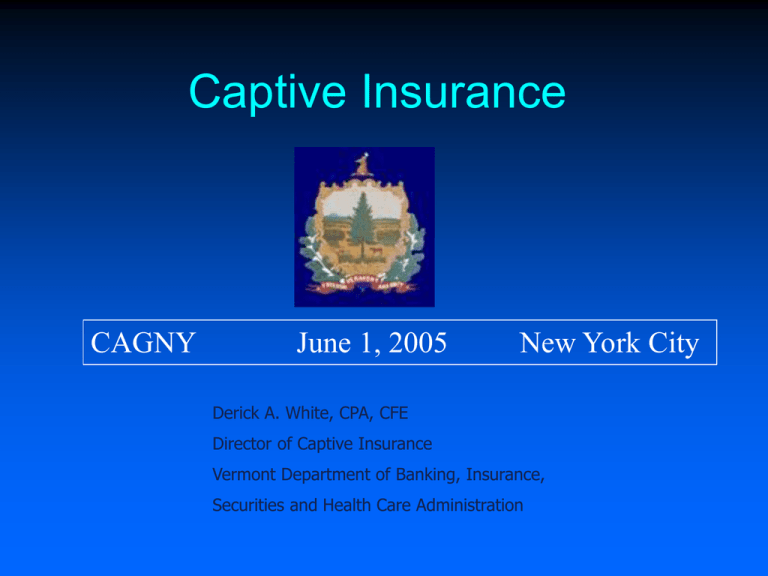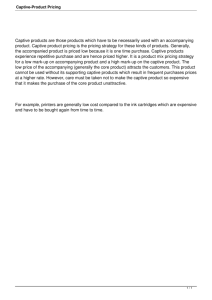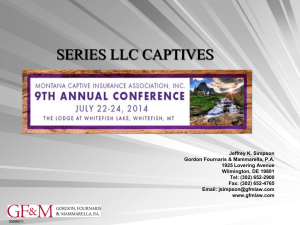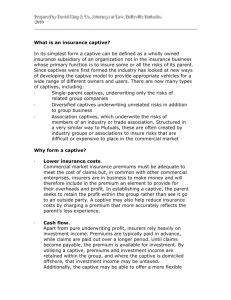Captive Insurance CAGNY June 1, 2005 New York City
advertisement

Captive Insurance CAGNY June 1, 2005 New York City Derick A. White, CPA, CFE Director of Captive Insurance Vermont Department of Banking, Insurance, Securities and Health Care Administration What is a Captive? “formalized self-insurance” wholly owned subsidiary licensed in a state (or country) a regulated insurance company with a limited license Why form a Captive? Obtain Coverage Control Cost Focus on Risk Management Manuscript Policy Pre-loss funding History Bermuda during the early 1970’s Colorado, Georgia, Tennessee Vermont in 1981 Hawaii in 1986 Recent States Types of Captives Pure Industrial Insured Association Risk Retention Groups Sponsored (Rent-A-Captives) Reciprocal Branch Some Coverages Currently Written with Captives General Liability Product Liability Workers Comp Auto Liability Auto Physical Damage Property Business Interruption Marine & Cargo Terrorism Environmental Impairment Credit Professional Liability Political/War Risk Aviation Strike Employee Benefits D&O Trends Medical Malpractice Terrorism Redomestication Vermont’s Captive Industry Profile numbers (over 700 licensed companies) management firms (14 active) service providers (CPA’s, banks, actuaries) Vermont Captive Insurance Association Total Number of Vermont Captive Licenses Issued 732 1981 1985 1989 1993 1997 2001 2005 2004 Financial Results Vermont Premium Written $ 10.6 billion Net Income $ 8.6 billion Total Assets $ 85.7 billion Capital & Surplus $ 51.2 billion Role of the Actuary Feasibility Study Annual Opinion Financial Projections Actuarial Review of applications Examinations Current Events Title/mortgage insurance Risk transfer GAO-risk retention groups NAIC accreditation Captive Insurance Companies William D. Motherway Executive Vice President Tishman Realty & Construction Co., Inc. A Brief History Historical Review Most early captives were wholly-owned ‘50s. By 1960 there were approx.. 100 captives in operation including some groups 80’s-90’s – Rent-A-captives and Cells Critical factors for development of the industry Availability of coverage problems Pricing inequity - swings from soft to hard markets leaving good risks with “Hats in Hand” Lack of flexibility with insurance coverage and wording Regulatory Responsiveness by Domiciles Changing Owner Needs Current Trends & Key Opportunities Property Programs Getting Fresh Look Return to Deductible & Retention Captives Hard Reinsurance Market – Lack of Support & Underwriting Contractors Nursing Homes Medical Malpractice D&O Property Many Others Terrorism Risk Insurance Act of 2002 Group Program Proliferation in Stressed Classes of Business Controls and Flexibility “Reasons for a Captive: Internalize Unbundle Access insurance program underwriting profits insurance services, reduce insurance costs to the reinsurance markets Enhance premium funds, cash flow and investment income Leverage markets, greater control, enhance strategic partnerships Policy design flexibility, specific to insured’s risk profile The Stage is Set All forms of Captives are subject common attributes: Financial Regulatory Control Flexibility What is a Captive and Who Uses them? Single-Owner (Pure) Captives - insure only the risks of the owner or the owner’s subsidiary operations (Exception controlled unaffiliated business) Companies with predictable attritional losses (high frequency. low severity) Companies with better than market average loss experience Companies with poor loss experience but committed to improved risk management Companies with uninsured risks Companies that wish to consolidate global programs Companies able to sell insurance products to their customers Key Financial Considerations Risk retained within the “economic” family Program loss sensitivity Additional fixed costs of captive operations Investment and liquidity Capital commitment (Cash , LOC’s, other) Tax deductibility (paid losses vs. loss reserves) Income and Local Taxes Each Structure discussed contains some or all of these Typical Design Structures Direct Writing Captive Retain all Risk or Cede Risk to a Reinsurance Partner Reinsuring / Assuming Captive Assumes risk from a fronting carrier or another ART vehicle Retains or retro-cedes to a reinsurance carrier Captive - Operating as a Direct Writer Insured Capitalization Insurance Premiums Captive Insurance Company (Owned by Insured) Claim Settlements Claimants Shareholder Dividends Captive - Operating as a Reinsurer Insured Shareholder Dividends Security to Guarantee Reimbursement of Losses Insurance Premiums Policy Issuing Company Premium Less Fronting Fee & Excess Insurance Capitalization Claim Settlements Reimbursement of Losses Captive Insurance Company (Owned by Insured) Claimants Risk Retention Group An RRG is an insurance entity owned and controlled by two or more non-affiliated organizations insured by the RRG. Homogeneous and insure similar types of businesses risks or Heterogeneous and insure risks of several types of organizations. RRGs in the United States are licensed to issue policies and and operate under the Federal Risk Retention Act of 1986. They are stock, reciprocal or mutual in organizational form. Association Captive An Association Captive is an insurance company owned and controlled by two or more non-affiliated association insured by the captive. Homogeneous and insure similar types of businesses risks or Heterogeneous and insure risks of several types of organizations. Association Captives in the United States are licensed by a domiciliary state (VT for example) and use a fronting carrier. They are stock, reciprocal or mutual in organizational form. Ownership Are insureds owners of the entity? In what way and how much? Joint and Several liability? Assessable policy? Withdrawals? Other? Management and Governance Board of Directors Officers Shareholders Professional Managers Investments Regulatory and Tax Issues State insurance regulation Possible use of a fronting carrier Liability Risk Retention Act of 1986 Financial responsibility laws Tax treatment of group captives Dividend distribution Service Providers Front carrier (if applicable) Reinsurance (specific and aggregate) Management Underwriting Claims and Loss Adjustment Actuarial Banking Investment Management Auditors Legal Counsel Benefits Better member service Lack of coverage and capacity fears eased Price no longer total market driven Long term relationship with knowledgeable partners Protection against competition Protection against market instability Profit driven Captive Forms - Rent-a-captive/ PCC A non-owned facility Clients do not contribute capital but instead rent it from the rent-acaptive sponsor Usually located off shore, e.g. Bermuda, Barbados, Guernsey or Cayman PCC law offers protection to rent-a-captive participants Affordable and quick option for most smaller companies Company selection criteria - cost of risk greater than $1m and net worth greater than $25m TRIMCO Insurance Company Overview Parent Company - Tishman Realty & Construction Co., Inc. Industry: Construction Hotels and Realty Real Estate TRIMCO Insurance Company Overview Details of Vermont Captive Licensed - December 2001 Operational - January 1, 2002 Program Structure: Direct Deductible Reimbursement - (Premium = $5.0M ) Workers Compensation General Liability No Loss Portfolio Transfer TRIMCO Insurance Company Overview Key Operational Components Start-up costs $25k Operational/Administrative Costs - $90k annually The Future Program Changes The floor is open for Questions





